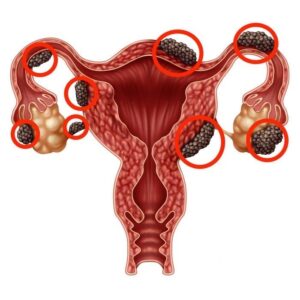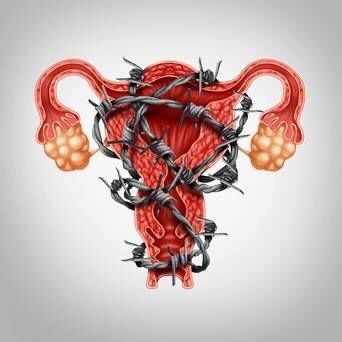Every year in March, Endometriosis Month is observed all around the world, with the aim of increasing and spreading awareness and highlighting the symptoms of this debilitating condition that affects so many women worldwide.
Endometriosis… What is that?

According to the National Health Service (NHS), a health care system in England,endometriosis is a condition where tissue similar to the lining of the womb grows in other places, such as the ovaries and fallopian tubes. Endometriosis can occur in any woman or young girl who has menstrual periods, but it is more common in women in their 30s and 40s. It is more likely to get endometriosis if one has never had children or has menstrual periods that last more than seven days.
Endometriosis has been proven to be a long-term medical condition that can have a significant impact on one’s life.
Symptoms of Endometriosis

Endometriosis symptoms can vary, but the most common and noticeable symptom is pelvic pain, which is often heightened during one’s menstruation period. Although many experience cramping during their menstrual periods, those with endometriosis typically describe menstrual pain that’s far worse than usual. Pain may also increase over time.
Common signs and symptoms of endometriosis may include:
- Painful periods (dysmenorrhea). Pelvic pain and cramping may begin before and extend several days into a menstrual period. You may also have lower back and abdominal pain.
- Experiencing pain with intercourse. Pain during or after sex is common with endometriosis.
- Pain with bowel movements or urination. You’re most likely to experience these symptoms during your menstrual period.
- Excessive bleeding. You may experience occasional heavy menstrual periods or bleeding between periods (intermenstrual bleeding).
- Infertility. Sometimes, endometriosis is first diagnosed in those seeking treatment for infertility.
- Other signs and symptoms. You may experience fatigue, diarrhoea, constipation, bloating, or nausea, especially during menstrual periods.
So, What Exactly Causes Endometriosis?
According to an article published on the Office of Women’s Health’s website, endometriosis happens when tissue similar to the lining of the uterus (womb) grows outside of the uterus.
No one knows for sure what causes this disease. Researchers are studying possible causes:
- Problems with menstrual period flow. Retrograde menstrual flow is the most likely cause of endometriosis. Some of the tissue shed during the period flows through the fallopian tube into other areas of the body, such as the pelvis.
- Genetic factors. Because endometriosis runs in families, it may be inherited.
- Immune system problems. A faulty immune system may fail to find and destroy endometrial tissue growing outside of the uterus. Immune system disorders and certain cancers are more common in women with endometriosis.
- Hormones. The hormone oestrogen appears to promote endometriosis. Research is looking at whether endometriosis is a problem with the body’s hormone system.
- Surgery. During a surgery to the abdominal area, such as a Caesarean (C-section) or hysterectomy, endometrial tissue could be picked up and moved by mistake. For instance, endometrial tissue has been found in abdominal scars.
Other Similar Medical Conditions
Although endometriosis is the most widely spoken about condition in women’s uterus, there are other, almost similar, medical conditions that also affect women as young as 16 years old. Polycystic ovary syndrome (PCOS) and uterine fibroids are also chronic conditions that affect women who are in their childbearing years. These three conditions are so severe that they may cause effects such as fertility issues in women.
Although these three conditions are not on the same level as each other in terms of severity, I thought I would squeeze them in so that you, reader, may inform us if you’d like us to do more research on them and share them here with you.
Treatments
Among other treatments for endometriosis, medication and surgery are the most common. The approach by which the doctor and patient choose a treatment usually depends on the severity of the signs and symptoms as well as the patient’s decision on whether they’re getting pregnant or not. Doctors typically recommend trying conservative treatment approaches first before opting for surgery if initial treatment fails.
Pain medication
Your doctor may recommend that you take an over-the-counter pain reliever, such as the nonsteroidal anti-inflammatory drugs (NSAIDs) ibuprofen (Advil, Motrin IB, and others) or naproxen sodium (Aleve), to help ease painful menstrual cramps. Your doctor may recommend hormone therapy in combination with pain relievers if you’re not trying to get pregnant. Always consult a health care professional before deciding to take any medication.
Hormone therapy
Supplemental hormones are sometimes effective in reducing or eliminating the pain of endometriosis. The rise and fall of hormones during the menstrual cycle causes endometrial implants to thicken, break down, and bleed. Hormone medication may slow endometrial tissue growth and prevent new implants of endometrial tissue. Hormone therapy isn’t a permanent fix for endometriosis. You could experience a return of your symptoms after stopping treatment.
For more read on the treatments of Endometriosis please do visit the Mayo Clinic website.
Women’s health is quite sensitive, especially when it comes to the reproductive system. March is endometriosis awareness month, and we at Afterbreak magazine ensure that we do not take health matters lightly and that we play our part to spread awareness.
To any of our readers who may be suffering from endometriosis, ovarian cysts, fibroids, or PCOS, we can only hope the best for you. If you don’t suffer from these but think you may have symptoms, do visit your gynaecologist just to be sure.




One Reply to “Spreading Awareness This Endometriosis Awareness Month”